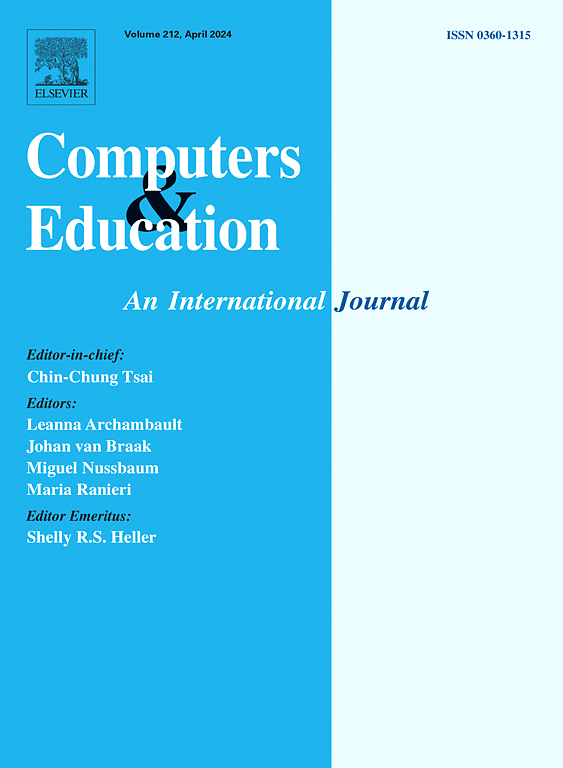基于聊天机器人的自我调节脚手架与在线协同反思相结合对学生人工智能课程学习的影响
IF 10.5
1区 教育学
Q1 COMPUTER SCIENCE, INTERDISCIPLINARY APPLICATIONS
引用次数: 0
摘要
人工智能(AI)包含复杂的概念,对于非计算机或信息专业的学生来说可能很难,他们可能会在人工智能课程中遇到困难。为了培养学生的人工智能技能,调节学生的学业压力,减少学生的孤独感,本研究将自我调节脚手架(由本研究设计的聊天机器人支持)与在线协作反思相结合,研究了它们对学生学习的影响。研究人员进行了一个准实验来探索自我调节脚手架和在线协作反思的影响。本实验的参与者是来自非计算机系三个班(组)的116名选修《人工智能导论》必修课的本科生。本研究的实验组包括第一组(G1)同时接受自我调节支架和在线协同反思干预,第二组(G2)只接受自我调节支架干预。最后一个班(G3)作为对照组,在人工智能在线课程中采用传统的教学方法(非自律脚手架和非在线协同反思)。根据本研究的统计分析,与对照组相比,G2的自我调节脚手架方法显著提高了参与者的AI技能,培养了他们调节学业压力的能力。然而,与未接受在线协作反思的G1学生相比,接受在线协作反思的G1学生并没有表现出预期的学习效果。本研究代表了在在线人工智能课程中实现自我调节脚手架和在线协作反思与聊天机器人集成的早期尝试。本研究的结果可以为计划采用这些教学方法的在线课程设计者、教育工作者和学者,特别是那些专注于实施在线人工智能教育和教育技术(如聊天机器人)的人提供参考。本文章由计算机程序翻译,如有差异,请以英文原文为准。
Effects of integrating self-regulation scaffolding supported by chatbot and online collaborative reflection on students’ learning in an artificial intelligence course
Artificial intelligence (AI) includes complex concepts and could be difficult for non-computer or information students, and they may experience difficulties in an AI course. In order to develop students' AI skills, regulate their academic stress, and reduce student loneliness, the researchers in this study integrated self-regulation scaffolding (supported by a chatbot designed in this study) with online collaborative reflection, and investigated their effects on students' learning. The researchers conducted a quasi-experiment to explore the effects of self-regulation scaffolding and online collaborative reflection. The participants in this experiment were 116 undergraduates from three classes (groups) of a non-computer department taking a compulsory course titled ‘Introduction to Artificial Intelligence’. The experimental groups in this study included the first class (G1) simultaneously receiving the interventions of self-regulation scaffolding and online collaborative reflection, as well as the second class (G2) only receiving the intervention of self-regulation scaffolding. The last class (G3), that received a traditional teaching method (non-self-regulation scaffolding and non-online collaborative reflection) in an online AI course, served as the control group. According to the statistical analysis in this study, the self-regulation scaffolding approach in G2 significantly promoted participants' AI skills and fostered their ability to regulate academic stress compared to the control group. However, G1 students who received concurrent online collaborative reflection did not demonstrate the expected effects of enhancing their learning compared with those (G2) who did not receive it. This study represents an early attempt to implement self-regulation scaffolding and online collaborative reflection integrated with chatbot in an online AI course. The results of this study could serve as a reference for online course designers, educators, and scholars planning to adopt these teaching methods, especially for those focusing on implementing online AI education and educational technologies (such as chatBot).
求助全文
通过发布文献求助,成功后即可免费获取论文全文。
去求助
来源期刊

Computers & Education
工程技术-计算机:跨学科应用
CiteScore
27.10
自引率
5.80%
发文量
204
审稿时长
42 days
期刊介绍:
Computers & Education seeks to advance understanding of how digital technology can improve education by publishing high-quality research that expands both theory and practice. The journal welcomes research papers exploring the pedagogical applications of digital technology, with a focus broad enough to appeal to the wider education community.
 求助内容:
求助内容: 应助结果提醒方式:
应助结果提醒方式:


